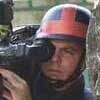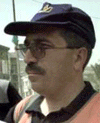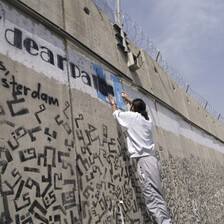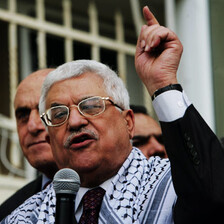The Electronic Intifada 30 December 2003

Mazen Dana
Looking back at journalists in danger in 2003, the words of Dana are unfortunately still true. Two journalists, a Palestinian cameraman and a British documentary filmmaker were killed by the Israeli army. Media watchdogs counted attacks and harrassment of journalists and the increasing restrictions imposed on foreign and Palestinian journalists.

Nazeh Darwazeh

James Miller
In 2003, Israeli forces attacked and harassed a number of Palestinian journalists. On January 21, AP photographer Nasser Ishtayeh and AFP photographer Jaafar Ishtayeh were attacked by Israeli border police after they tried to take a picture of their army jeep. They were trying to photograph two Palestinian youths who were on the hood of the moving jeep and who the journalists believed were being used as human shields as the troops advanced on Palestinians throwing stones in the area. The Israeli army jeep drove in their direction, stopped, and three Israeli soldiers approached them. The soldiers immediately began to punch the two photographers and insulted them. Both journalists said that their clothing and camera equipment were clearly marked “Press.” Afterwards they were dragged a few meters by their camera straps to the army jeep’s driver, who had remained in the car while the beatings occurred. The driver inspected the cameras, which, because they were digital, allowed him to view recent images. He then threatened the journalists and told them that if he saw any of their pictures in the newspaper, he would kill them. Nasser Ishtayeh suffered light wounds on his face, and Jaafar Ishtayeh was injured slightly on his hand.
On March 6, Shams Odeh, a Reuters cameraman, and Ahmad Jadallah, a Reuters photographer, were injured in Gaza during an Israeli army raid on the Jabalya refugee camp. They were both injured by shrapnel from an explosion in the camp. Israeli forces were leaving the refugee camp at the end of the raid when an Israeli tank fired two rounds. The first round set a building on fire, and crowds of people poured into the streets to watch firefighters douse the blaze. The journalists, who were among the people in the street, were covering the aftermath of the raid. Witnesses claim that the tank’s second round was fired at the group who had gathered, injuring the two journalists. Both of Jadallah’s legs were broken, and one artery in his leg was severed after being hit by shrapnel. He underwent surgery in a Gaza hospital before being moved to an Israeli hospital in Jerusalem. Odeh suffered moderate injuries to his foot. He underwent surgery in Gaza.
On May 20, Shaaban Qandil, an ANN cameraman, and Jospeh Handal, a cameraman with France 2, were brutally assaulted by Israeli soldiers in Bethlehem. Qandil and Handal had just left Handal’s residence in Bethlehem a little after midnight when several Israeli troops in jeeps stopped Handal’s carm which was marked “TV”. Two of the Israeli soldiers ordered Handal to leave his car. He complied but told the Israeli soldiers that he is a journalist. Within moments, they began to beat Handal and he fell to the ground. Right before Handal had left the car, he gave Qandil his mobile phone. When some of the Israeli soldiers noticed he was about to make a call as Handal was being beaten, he was pulled out of the car and beaten as well. Both journalists sustained fractures to their right hands. Friends took them to a local hospital for treatment soon after the Israeli soldiers left the area.
On October 21, Israeli forces in Ramallah raided the office of Al-Jazeera. Israeli forces had entered the office in nearby El-Bireh and asked the staff and journalists to close the doors and remain inside. The station broadcast live footage of an Israeli officer arguing with correspondents and staff members.
As journalists working in the occupied Palestinian territories remain in danger, more restrictions on the press are expected for 2004. On November 2, the Israeli Government Press Office announced new administrative guidelines for press accreditation that set to take effect this week. The guidelines include a provision requiring Israel’s security service, Shin Bet, to vet candidates seeking accreditation. The guidelines will give the GPO and Shin Bet means to prevent accreditation to anyone they don’t like reporting events on the ground. In the past this has been used against Palestinian journalists.
The new guidelines will directly affect foreign correspondents and Israeli reporters who cover the occupied territories. They follow other restrictive measures adopted by the GPO in recent years, which have resulted in complaints from the international media. In 2002, GPO froze the accreditation of most Palestinian journalists from the occupied territories who work with foreign media. The Foreign Press Association (FPA) stated that the new measures provide the authorities “unreasonable veto power over who can serve as a foreign correspondent.”
Related Links


